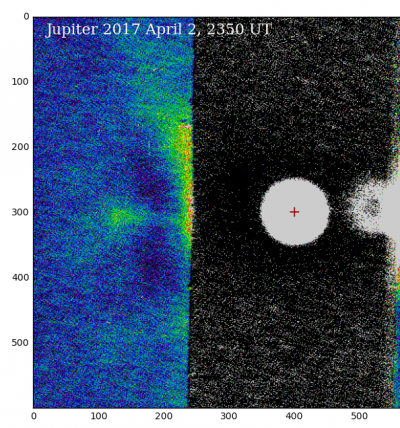Planetary science: imaging the sulphur torus of Io from UCLO

Using the C14 telescopes at UCLO, we have performed imaging of the sulphur torus of Io, one of the moons of Jupiter. Io is one of the most active moons in the Solar System, well known for its volcanic plumes and lava flows. Hot gases ejected from its active surface may become ionized, forming a plasma that is captured by Jupiter's strong magnetic field to form a co-rotating plasma torus, consisting mainly of ionized sulphur and oxygen atoms.
This work has been carried out in collaboration with Prof. Nick Achilleos (UCL Physics and Astronomy), and other colleagues, who researches the magnetospheres and environments of the giant planets in the Solar System; our effort has been supported by an RAS Patricia Tomkins Award.
The observations were carried out using a customized focal-plane reimager (built in house by Mick Pearson), equipped with a narrow-band filter to select emission from ionized sulphur atoms. The bright light of Jupiter was masked in the focal plane with a neutral-density filter.
The narrow-band filter was first characterized by a small team of 2nd-yr undergraduate students (Martina Aghopian, Ian Hothi, Paula Soares); imaging was then carried out using the C14 telecope and focal-plane reimager over several nights in the spring of 2017 by Roman Gerasimov (BSc Astrophysics, 2018) and Dominic Mo (MSc Planetary Science, 2017), supported by Dr. Steve Fossey.
After removal of scattered light from Jupiter, and in spite of Jupiter being very low in the sky as viewed from UCLO, we were able to achieve a positive detection of the sulphur torus of Io. In the false-colour image shown below (total exposure = 50 minutes), Jupiter is centred on the red cross in the masked region to the right; the part of the Io torus which we have detected is the green-coloured feature visible at about (x,y) = (150,300) (the red/green features just left of the black mask are residual scattered light from Jupiter itself).

We will continue to develop the imaging methods to improve and enhance the capability with which we can observe the Io torus; our hope is that we will be able to obtain sufficient precision to detect variations in the brightness of the Io torus due to changes in the rate of sulphur emisson by Io.
 Close
Close

